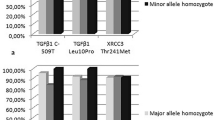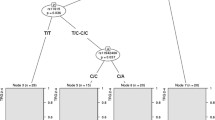Abstract
Background and Purpose
Vascular endothelial growth factor (VEGF) is an important determinant of microvascular permeability and angiogenesis and has been shown to be up-regulated during the late phase of radiation injury. The present prospective study was performed to evaluate the role of VEGF gene polymorphisms and haplotypes in the development of radiation-induced late side effects in prostate cancer patients.
Patients and Methods
The association of VEGF gene polymorphisms and haplotypes with high-grade late rectal or urinary toxicity (defined as late toxicity EORTC/RTOG ≥2) was analyzed using 493 prostate cancer patients from the Austrian PROCAGENE study treated with definitive radiotherapy. Seven candidate polymorphisms in the VEGF gene were selected and determined by 5’-nuclease (TaqMan) assays.
Results
Within a median follow-up time of 48 months, 42 patients (8.6%) developed high-grade late rectal and 47 patients (9.6%) urinary toxicity, respectively. In a Kaplan–Meier analysis, carriers of the VEGF -7C > T polymorphism were at increased risk of high-grade late rectal toxicity (p = 0.003) and in a multivariate analysis including clinical and dosimetric parameters as potential confounders the VEGF -7C > T polymorphism remained a significant predictor (HR = 2.8, 95% CI 1.349–5.813; p = 0.006). Furthermore, the ATTGT haplotype formed by five polymorphisms upstream of the coding sequence demonstrated a significant association with late rectal toxicity grade ≥2 (p = 0.001). No significant associations were found for the remaining polymorphisms and haplotypes.
Conclusion
We conclude that genetic variants in the VEGF gene may influence the risk of high-grade late rectal toxicity after definitive radiotherapy for prostate cancer.
Zusammenfassung
Hintergrund
Vascular endothelial growth factor (VEGF) ist ein wichtiger Regulator der Gefäßpermeabilität und Angiogenese, und in der chronischen Strahlenreaktionsphase wurde die Hochregulation von VEGF gezeigt. Ziel der vorliegenden prospektiven Studie war die Analyse des Zusammenhangs von VEGF-Genpolymorphismen und -Haplotypen mit dem Auftreten von radiogenen Spätfolgen bei Prostatakarzinompatienten.
Patienten und Methoden
Der Zusammenhang zwischen VEGF-Genpolymorphismen und -Haplotypen und höhergradigen rektalen und urogenitalen Spätfolgen (definiert als Spättoxizität EORTC/RTOG ≥2) wurde bei 493 Prostatakarzinompatienten der PROCAGENE-Studie, die einer definitiven Strahlentherapie unterzogen wurden, untersucht. 7 Kandidatenpolymorphismen wurden ausgewählt und mittels 5´-Nuklease-Assays (TaqMan) analysiert.
Ergebnisse
Während einer medianen Nachbeobachtungszeit von 48 Monaten entwickelten 42 Patienten (8,6%) höhergradige rektale und 47 Patienten (9,6%) urogenitale Nebenwirkungen. In der Kaplan-Meier-Analyse zeigten Träger des VEGF -7C > T-Poly-morphismus ein erhöhtes Risiko für höhergradige rektale Spätfolgen (p = 0,003; Abbildung 2) und in der multivariaten Analyse, in welche klinische und dosimetrische Faktoren eingeschlossen wurden, blieb der VEGF -7C > T-Polymorphismus ein signifikanter Prediktor (HR = 28; 95%-CI 1,349–5,813; p = 0,006, Tabelle 4). Zusätzlich zeigte sich für den ATTGT-Haplotyp, bestehend aus 5 vor der kodierenden Sequenz liegenden Polymorphismen, eine signifikante Assoziation mit höhergradiger rektaler Spättoxizität (p = 0,001; Abbildung 3). Keine signifikanten Assoziationen wurden für die übrigen untersuchten Polymorphismen und Haplotypen gefunden (Tabellen 3 und 4).
Schlussfolgerung
Die vorliegenden Daten zeigen, dass Varianten im VEGF-Gen möglicherweise das Auftreten von höhergradigen rektalen Spätfolgen nach definitiver Radiotherapie des Prostatakarzinoms beeinflussen.
Similar content being viewed by others
References
Abhary S, Burdon KP, Gupta A et al. Common sequence variation in the VEGFA gene predicts risk of diabetic retinopathy. Invest Ophthalmol Vis Sci 2009;50:5552–8.
Andreassen CN, Alsner J, Overgaard M et al. Prediction of normal tissue radiosensitivity from polymorphisms in candidate genes. Radiother Oncol 2003;:127–35.
Anscher MS, Chen L, Rabbani Z et al. Recent progress in defining mechanisms and potential targets for prevention of normal tissue injury after radiation therapy. Int J Radiat Oncol Biol Phys 2005;62:255–9.
Anscher MS, Vujaskovic Z. Mechanisms and potential targets for prevention and treatment of normal tissue injury after radiation therapy. Semin Oncol 2005;32:86–91.
Azria D, Ozsahin M, Kramar A et al. Single nucleotide polymorphisms, apoptosis, and the development of severe late adverse effects after radiotherapy. Clin Cancer Res 2008;14:6284–8.
Barcellos-Hoff MH, Park C, Wright EG. Radiation and the microenvironment — tumorigenesis and therapy. Nat Rev Cancer 2005;5:867–75.
Beddy D, Watson RW, Fitzpatrick JM et al. Increased vascular endothelial growth factor production in fibroblasts isolated from strictures in patients with Crohn’s disease. Br J Surg 2004;91:72–7
Breunis WB, Biezeveld MH, Geissler J et al. Vascular endothelial growth factor gene haplotypes in Kawasaki disease. Arthritis Rheum 2006;54:1588–94.
Burri RJ, Stock RG, Cesaretti JA et al. Association of single nucleotide polymorphisms in SOD2, XRCC1 and XRCC3 with susceptibility for the development of adverse effects resulting from radiotherapy for prostate cancer. Radiat Res 2008;170:49–59.
Cesaretti JA, Stock RG, Atencio DP et al. A genetically determined dose volume histogram predicts for rectal bleeding among patients treated with prostate brachytherapy. Int J Radiat Oncol Biol Phys 2007;68:1410–6.
Chang-Claude J, Ambrosone CB, Lilla C et al. Genetic polymorphisms in DNA repair and damage response genes and late normal tissue complications of radiotherapy for breast cancer. Br J Cancer 2009;100:1680–6.
Chintalgattu V, Nair DM, Katwa LC. Cardiac myofibroblasts: a novel source of vascular endothelial growth factor (VEGF) and its receptors Flt-1 and KDR. J Mol Cell Cardiol 2003;35:277–86.
Cox JD, Stetz J, Pajak TF. Toxicity criteria of the Radiation Therapy Oncology Group (RTOG) and the European Organization for Research and Treatment of Cancer (EORTC). Int J Radiat Oncol Biol Phys 1995;31:1341–6.
Damaraju S, Murray D, Dufour J et al. Association of DNA repair and steroid metabolism gene polymorphisms with clinical late toxicity in patients treated with conformal radiotherapy for prostate cancer. Clin Cancer Res 2006;12:2545–54.
De Ruyck K, Van Eijkeren M, Claes K et al. Radiation-induced damage to normal tissues after radiotherapy in patients treated for gynecologic tumors: association with single nucleotide polymorphisms in XRCC1, XRCC3, and OGG1 genes and in vitro chromosomal radiosensitivity in lymphocytes. Int J Radiat Oncol Biol Phys 2005;62:1140–9.
Dvorak HF. Vascular permeability factor/vascular endothelial growth factor: a critical cytokine in tumor angiogenesis and a potential target for diagnosis and therapy. J Clin Oncol 2002;20:4368–80.
Dvorak HF, Brown LF, Detmar M et al. Vascular permeability factor/vascular endothelial growth factor, microvascular hyperpermeability, and angiogenesis. Am J Pathol 1995;146:1029–39.
Ferrara N, Gerber HP, LeCouter J. The biology of VEGF and its receptors. Nat Med 2003;9:669–676.
García-Closas M, Malats N, Real FX et al. Large-scale evaluation of candidate genes identifies associations between VEGF polymorphisms and bladder cancer risk. PLoS Genet 2007;3:e29.
Giotopoulos G, Symonds RP, Foweraker K et al. The late radiotherapy normal tissue injury phenotypes of telangiectasia, fibrosis and atrophy in breast cancer patients have distinct genotype-dependent causes. Br J Cancer 2007;96:1001–7.
Guckenberger M, Ok S, Polat B et al. Toxicity after Intensity modulated, image-guided radiotherapy for prostate cancer. Strahlenther Onkol 2010;186:535–43. Erratum in: Strahlenther Onkol 2010;186:705.
Hermesse J, Biver S, Jansen N et al. A dosimetric selectivity intercomparison of HDR brachytherapy, IMRT and helical tomotherapy in prostate cancer radiotherapy. Strahlenther Onkol 2009;185:736–42.
Hicklin DJ, Ellis LM. Role of the vascular endothelial growth factor pathway in tumor growth and angiogenesis. J Clin Oncol 2005;23:1011–27.
Jaal J, Dörr W. Radiation induced late damage to the barrier function of small blood vessels in mouse bladder. J Urol 2006;176:2696–700.
Jacob V, Bayer W, Astner ST et al. A planning comparison of dynamic IMRT for different collimator leaf thicknesses with helical tomotherapy and RapidArc for prostate and head and neck tumors. Strahlenther Onkol 2010;186:502–10.
Jain L, Vargo CA, Danesi R, et al. The role of vascular endothelial growth factor SNPs as predictive and prognostic markers for major solid tumors. Mol Cancer Ther 2009;8:2496–508.
Kerns SL, Ostrer H, Stock R et al. Genome-wide association study to identify single nucleotide polymorphisms (SNPs) associated with the development of erectile dysfunction in African-American men after radiotherapy for prostate cancer. Int J Radiat Oncol Biol Phys 2010;78:1292–300.
Kobayashi T, Liu X, Wen FQ et al. Smad3 mediates TGFbeta 1 induction of VEGF production in lung fibroblasts. Biochem Biophys Res Commun 2006;339:290–5.
Langsenlehner T, Langsenlehner U, Renner W et al. The Glu228Ala polymorphism in the ligand binding domain of death receptor 4 is associated with increased risk for prostate cancer metastases. Prostate 2008;68:264–8.
Langsenlehner U, Krippl P, Renner W et al. Interleukin-10 promoter polymorphism is associated with decreased breast cancer risk. Breast Cancer Res Treat 2005;90:113–5.
Liu AK, Macy ME, Foreman NK. Bevacizumab as therapy for radiation necrosis in four children with pontine gliomas. Int J Radiat Oncol Biol Phys 2009;75:1148–54.
Liu Y, Kudo K, Abe Y et al. Hypoxia expression in radiation-induced late rectal injury. J Radiat Res 2008;49:261–8.
Liu Y, Kudo K, Abe Y et al. Inhibition of transforming growth factor beta, hypoxia- inducible factor-1alpha and vascular endothelial growth factor reduced late rectal injury induced by irradiation. J Radiat Res 2009;50:233–9.
Matuschek C, Bölke E, Nawatny J et al. Bevacizumab as a Treatment Option for Radiation Induced Cerebral Necrosis. Strahlenther Onkol 2011;187:135–9.
Minchenko A, Salceda S, Bauer T et al. Hypoxia regulatory elements of the human vascular endothelial growth factor gene. Cell Mol Biol Res 1994;40:35–9.
Nordal RA, Nagy A, Pintilie M et al. Hypoxia and hypoxia-inducible factor-1 target genes in central nervous system radiation injury: a role for vascular endothelial growth factor. Clin Cancer Res 2004;10:3342–53.
Peters CA, Stock RG, Cesaretti JA et al. TGFB1 single nucleotide polymorphisms are associated with adverse quality of life in prostate cancer patients treated with radiotherapy. Int J Radiat Oncol Biol Phys 2008;70:752–9.
Quarmby S, Fakhoury H, Levine E et al. Association of transforming growth factor beta-1 single nucleotide polymorphisms with radiation-induced damage to normal tissues in breast cancer patients. Int J Radiat Biol 2003;79:137–43.
Rabbani ZN, Mi J, Zhang Y et al. Hypoxia inducible factor 1alpha signaling in fractionated radiation-induced lung injury: role of oxidative stress and tissue hypoxia. Radiat Res 2010;173:165–74.
Rodemann HP, Blaese MA. Responses of normal cells to ionizing radiation. Semin Radiat Oncol 2007;17:81–8.
Rofstad EK, Gaustad JV, Egeland TA et al. Tumors exposed to acute cyclic hypoxic stress show enhanced angiogenesis, perfusion and metastatic dissemination. Int J Cancer 2010;127:1535–46.
Schultz A, Lavie L, Hochberg I et al. Interindividual heterogeneity in the hypoxic regulation of VEGF: significance for the development of the coronary artery collateral circulation. Circulation 1999;100:547–52.
Stephens M, Smith NJ, Donnelly P. A new statistical method for haplotype reconstruction from population data. Am J Hum Genet 2001;68:978–89.
Torcuator R, Zuniga R, Mohan YS et al. Initial experience with bevacizumab treatment for biopsy confirmed cerebral radiation necrosis. J Neurooncol 2009;94:63–8.
Tsoutsou PG, Koukourakis MI. Radiation pneumonitis and fibrosis: mechanisms underlying its pathogenesis and implications for future research. Int J Radiat Oncol Biol Phys 2006;:1281–93.
Vujaskovic Z, Anscher MS, Feng QF et al. Radiation-induced hypoxia may perpetuate late normal tissue injury. Int J Radiat Oncol Biol Phys 2001;50:851–5.
Werbrouck J, De Ruyck K, Duprez F et al. Acute normal tissue reactions in head-and-neck cancer patients treated with IMRT: influence of dose and association with genetic polymorphisms in DNA DSB repair genes. Int J Radiat Oncol Biol Phys 2009;73:1187–95.
Wolff D, Stieler F, Hermann B et al. Clinical implementation of volumetric intensity-modulated arc therapy (VMAT) with ERGO++. Strahlenther Onkol 2010;186:280–8.
Yamamori M, Sakaeda T, Nakamura T et al. Association of VEGF genotype with mRNA level in colorectal adenocarcinomas. Biochem Biophys Res Commun 2004;325:144–50.
Yoshiji H, Kuriyama S, Yoshii J et al. Vascular endothelial growth factor and receptor interaction is a prerequisite for murine hepatic fibrogenesis. Gut 2003;52:1347–54.
Yuan X, Liao Z, Liu Z et al. Single Nucleotide Polymorphism at rs1982073:T869C of the TGFb1 gene is associated with the risk of radiation pneumonitis in patients with non-small-cell lung cancer treated with definitive radiotherapy. J Clin Oncol 2009;27:3370–8.
Author information
Authors and Affiliations
Corresponding author
Rights and permissions
About this article
Cite this article
Langsenlehner, T., Renner, W., Gerger, A. et al. Impact of VEGF gene polymorphisms and haplotypes on radiation-induced late toxicity in prostate cancer patients. Strahlenther Onkol 187, 784–791 (2011). https://doi.org/10.1007/s00066-011-1106-4
Received:
Accepted:
Published:
Issue Date:
DOI: https://doi.org/10.1007/s00066-011-1106-4




